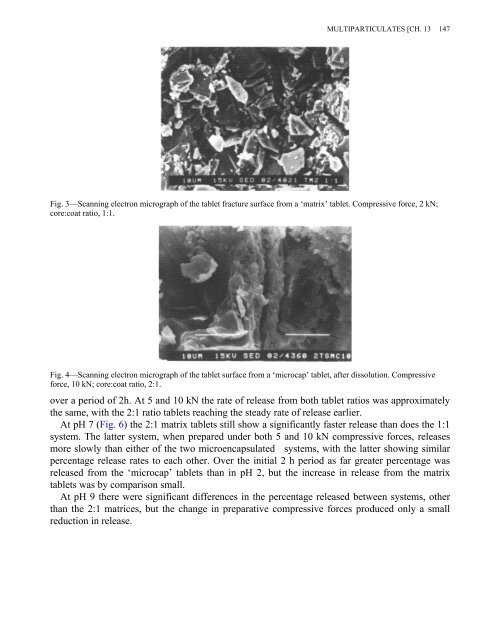Pharmaceutical Technology: Controlled Drug Release, Volume 2
Pharmaceutical Technology: Controlled Drug Release, Volume 2
Pharmaceutical Technology: Controlled Drug Release, Volume 2
You also want an ePaper? Increase the reach of your titles
YUMPU automatically turns print PDFs into web optimized ePapers that Google loves.
MULTIPARTICULATES [CH. 13 147<br />
Fig. 3—Scanning electron micrograph of the tablet fracture surface from a ‘matrix’ tablet. Compressive force, 2 kN;<br />
core:coat ratio, 1:1.<br />
Fig. 4—Scanning electron micrograph of the tablet surface from a ‘microcap’ tablet, after dissolution. Compressive<br />
force, 10 kN; core:coat ratio, 2:1.<br />
over a period of 2h. At 5 and 10 kN the rate of release from both tablet ratios was approximately<br />
the same, with the 2:1 ratio tablets reaching the steady rate of release earlier.<br />
At pH 7 (Fig. 6) the 2:1 matrix tablets still show a significantly faster release than does the 1:1<br />
system. The latter system, when prepared under both 5 and 10 kN compressive forces, releases<br />
more slowly than either of the two microencapsulated systems, with the latter showing similar<br />
percentage release rates to each other. Over the initial 2 h period as far greater percentage was<br />
released from the ‘microcap’ tablets than in pH 2, but the increase in release from the matrix<br />
tablets was by comparison small.<br />
At pH 9 there were significant differences in the percentage released between systems, other<br />
than the 2:1 matrices, but the change in preparative compressive forces produced only a small<br />
reduction in release.

















